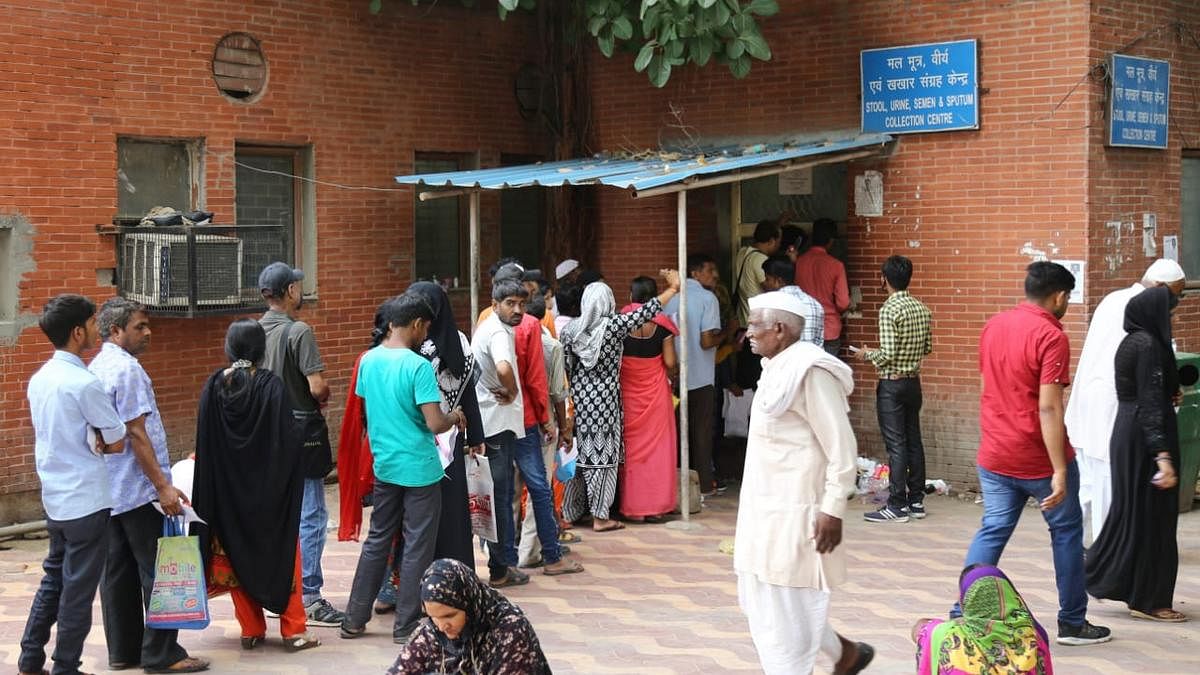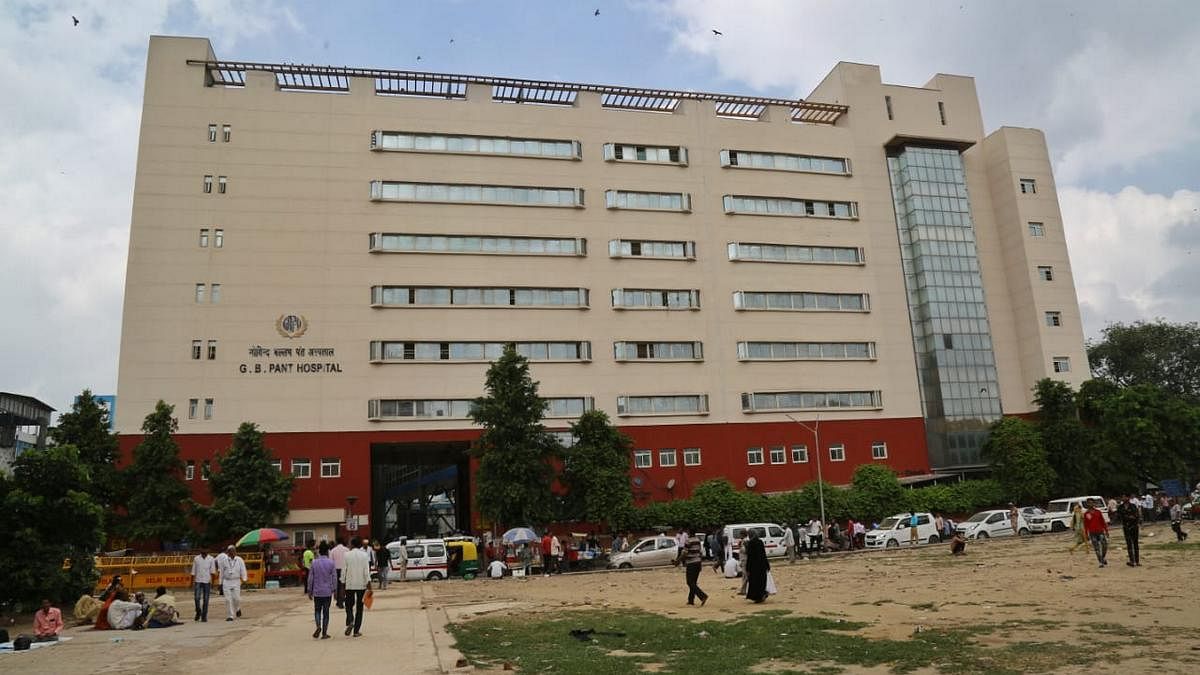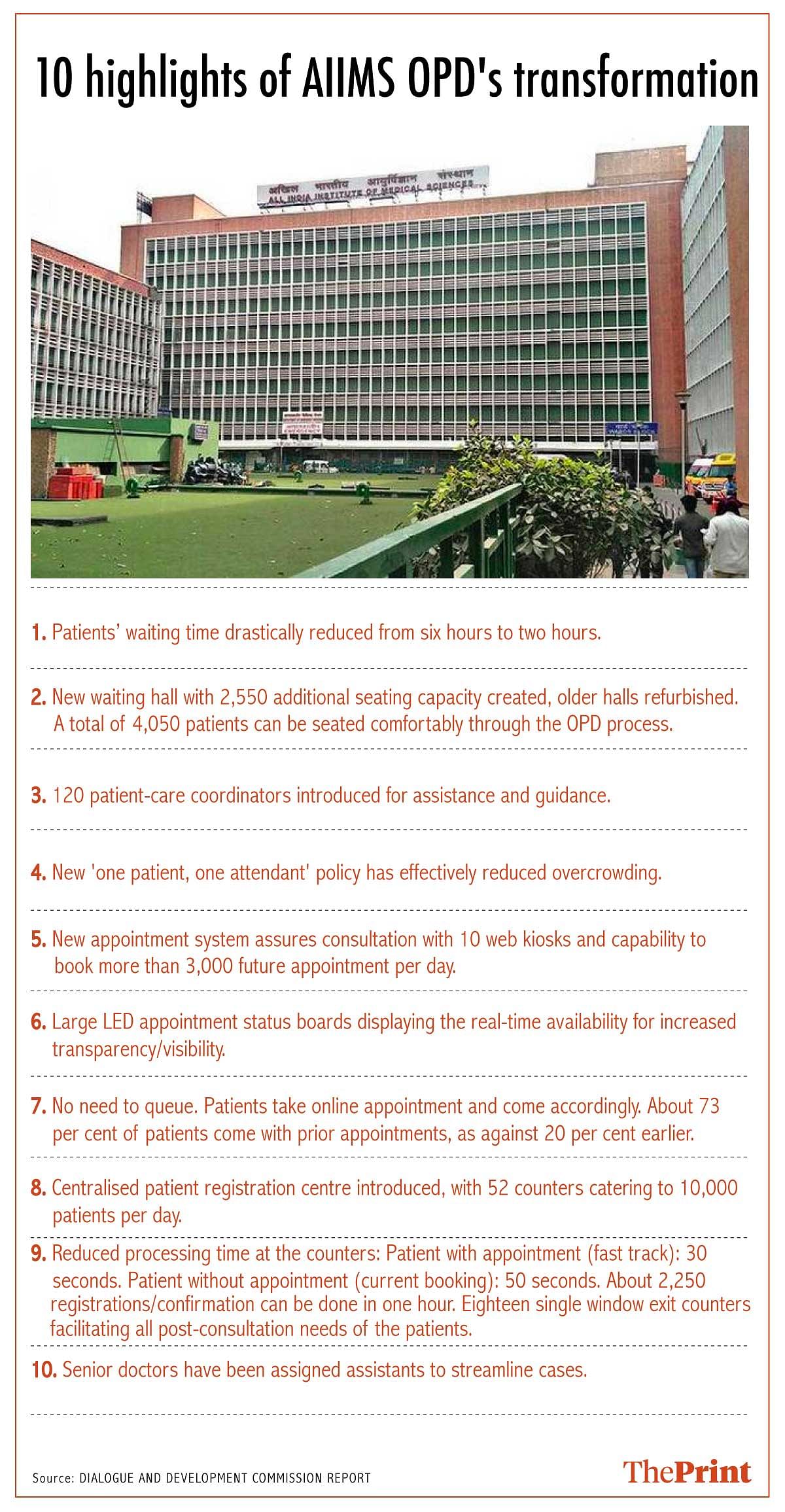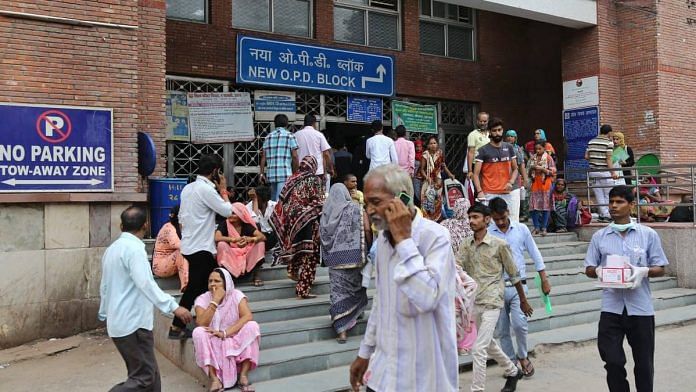New Delhi: Delhi Chief Minister Arvind Kejriwal last week announced a “mega health expansion plan”, claiming that the capacity of Delhi government hospitals would increase by 120 per cent by 2023.
Nearly two years ago, Kejriwal had made another announcement — promising a slew of measures to improve the condition of Delhi government hospitals that had been described as “pathetic” by the Dialogue and Development Commission, an advisory body to his government.
It’s a promise Kejriwal is yet to fulfill.
Directed Health dept today to develop most modern Hospital Management Information System of international standards to integrate all Del govt hospitals, Moh clinics n polyclinics. This will remove crowds n dramatically improve public experience at Del govt hospis
— Arvind Kejriwal (@ArvindKejriwal) January 17, 2018
The DDC had studied the centre-run All India Institute of Medical Sciences (AIIMS) and Safdarjung Hospital to make recommendations about reducing overcrowding and improving public experience, developing a modern health management system, computerisation and a host of other measures. But none of the recommendations has been implemented yet, and the people at these hospitals continue to suffer.
Also read: Kejriwal’s report card — how Delhi’s AAP govt fared on its 70 manifesto promises from 2015
‘Disarray and mismanagement’
The DDC report, accessed by ThePrint, was based on a survey conducted over two months. Its team visited three Delhi government hospitals — G.B. Pant Institute of Postgraduate Medical Education and Research (GIPMER), the LNJP Hospital and the Maulana Azad Institute of Dental Sciences (MAIDS) — as well as AIIMS, Safdarjung and the privately-run Sir Ganga Ram Hospital.
The survey focused on new patients’ registration in OPD, follow-up appointments in OPD, in-patient registrations, pharmacy counters and lab & radiology counters. What it found was found long queues, inordinate waiting time for patients, mismanagement and inefficiency.
It stated that “there was disarray and mismanagement and resultant patient dissatisfaction” at the Delhi government hospitals, and that “urgent reforms and actions are required to ameliorate the situation”.
GIPMER has a daily OPD footfall of around 8,000 patients, while at LNJP, the number is 9,000. In both hospitals, this leads to chaotic scenes. According to the report, “given the rising population of Delhi and the steady increase in the number of patients from neighbouring states, Delhi government hospitals will see on an average a 10 per cent increase in patients’ foot fall every year. This will make matters worse”.
When ThePrint visited GIPMER to see the state of affairs, a 56-year woman named Lalita from Jangpura said, “The CM has done a lot for Delhi, but something needs to be done about these queues in hospitals. I’m getting old standing here, and it is very difficult when one is unwell.”

It was a similar situation at LNJP Hospital.
Anwar, a resident of south Delhi’s Lado Sarai, who had come to LNJP in central Delhi for his wife’s check-up, said, “Whenever we have to come, it has to be early in the morning, or we don’t find a place in the queue.”
Ironically, the report had mentioned Anwar’s locality, Lado Sarai, to make a point about patients visiting smaller nearby hospitals rather than crowding the big hospitals.
“For instance, a patient with orthopaedic condition living in Lado Sarai need not rush to LNJP hospital to consult an orthopaedic doctor. The call centre can help him locate this service closer to his neighbourhood such as Pt Madan Mohan Malaviya Hospital. This will help to address the issue of underutilisation of smaller hospitals and the disproportionate rush at big hospitals,” the DDC report stated.
The corridors of LNJP serve many purposes — with people waiting, sitting, sleeping and eating there. When asked, on the condition of anonymity, one person told ThePrint, “We came from Uttar Pradesh for my wife’s treatment. Now we don’t have money to stay and keep the treatment going. This hospital also does not have any waiting area. So we have to live here. We manage to stay here by requesting the guards because they understand our plight.”
At the LNJP pharmacy, it was a similar scene, with several people waiting in lines to get medicine. While the Delhi government’s free medicine scheme is popular, it has also given rise to chaos as there is mismanagement in its implementation.
“We come to the hospital around 7am. First, we deal with huge queues in the OPD registration. Then we wait for our turn for check-up, and then we have to wait for at least 1-1.5 hours to get the medicine from the counters. You have to keep standing the whole time. It’s exhausting,” said a man who’d been waiting since morning.
Also read: To win Delhi polls, AAP is taking tips from Modi, Amarinder, Nitish & Jagan campaigns
Lack of digitisation
The report also suggested digitisation and automation as a solution, taking a cue from AIIMS. It called the state of computerisation at GIPMER and LNJP “unsatisfactory” and the approach to automation of patient management systems “ad-hoc and fragmented”.
It suggested that it would be wise to go ahead with National Informatics Centre (NIC)-developed systems that AIIMS has adopted, or any other such software.
“The practice of each hospital developing its own software will add to confusion. What we need is a common platform across all hospitals, dispensaries and even mohalla clinics,” it stated.
Currently, the OPD registration process is manual in most Delhi government hospitals, and, therefore, long and tedious. There are separate queues for old and new OPD cases as well as for male and female patients.
At GIPMER, patients struggled to get in queues and waited for long hours before seeing a doctor, given there is hardly any seating and no token system.

There is no digital OPD registration at GIPMER. At LNJP, there are computers in the OPD, but with software that the report calls “elementary and unsophisticated to meet the ever increasing work pressure”.
A nurse at GIPMER, requesting anonymity, told ThePrint that the gastroenterology and neurology departments stop registration after 40 new cases every day due to a shortage of senior consultants.
The DDC report recommended an online registration and appointment booking system, which could be accessed by people via mobile phones or computers. Upon registration, an SMS will be generated with details.
Based on the report, the AAP government also said it would introduce a centralised helpline and a call centre to cater to patients looking for guidance in identifying the right medical facility and securing a doctor’s appointment.
Nimmi Rastogi, leader for the health sphere at DDC, who was involved in the survey, said: “Computerisation and digitisation of records might seem like a petty issue while addressing health services, but it actually is quite relevant. It improves doctor-patient coordination, can help provide real-time information and aid to a patient in emergency.”
Rastogi added that digitisation also helps in bridging the rural-urban divide by extending free consultation, in terms of which doctor is available for treatment where in Delhi.
Also read: Arvind Kejriwal’s AAP got Rs 185 crore in donations since 2012 — 75% from outside Delhi
e-Hospital
Referring to how AIIMS and Safdarjung had an e-Hospital system in place, the DDC report said it would be appropriate for Delhi government hospitals as well.
e-Hospital is an open source health information management system that is designed to deploy cloud infrastructure to manage multiple hospitals seamlessly. It is a one-stop solution to address these concerns and connect patients, hospitals and doctors on the digital platform.
“Some half-hearted attempt to roll-out e-hospital at GB Pant was made in 2015 but due to lack of leadership both at the Secretariat and at the hospital level, the project has not taken off,” stated the report.
In 2015, a ‘request for proposal’ was floated to engage a private IT company to develop a health information management digital system at Delhi government hospitals. But the RFP process was subsequently scrapped.
Gopal Mohan, senior adviser to the Delhi CM, told ThePrint: “The project was a fitting example to address overcrowding and delay caused in government hospitals, but certain approvals didn’t come about as there weren’t too many takers when the tender was floated. We even reopened it, but somehow things didn’t materialise.”
The report also proposed setting up a single-click interface that gives access to the CM and health minister about vital information on health services, including the availability of medicines, beds and number of patients attended, investigations done and surgeries performed at all government facilities.
AIIMS’ OPD transformation and lessons from it
A DDC member, who did not wish to be identified, pointed out that the situation was similar at AIIMS before it transformed.
“AIIMS was in the same condition. It is just that it managed to rope in Tata Consultancy Services as part of a corporate social responsibility project, and that helped it improve,” the member said.
One of the most important suggestions the DDC made was to implement an AIIMS-style ‘one patient, one attendant’ policy, pointing out that multiple attendants add to the congestion and chaos, with fights erupting frequently. It also recommended no entry for minors as attendants unless deemed necessary.

Government officials also pointed out that four of every 10 patients seen by a doctor are follow-up cases who travel long distances with multiple attendants/family members. That’s why the DDC also recommended that such patients be handled through ‘Telemedicine’, similar to the scheme AIIMS Patna has implemented.
‘Telemedicine’ is the remote delivery of healthcare services, such as health assessments or consultations, over the telecommunications infrastructure. It allows healthcare providers to evaluate, diagnose and treat patients using common technology, such as video conferencing.
The report stated the hospital had treated over 5 lakh patients this way between 2012 and 2017, and this could be replicated at Delhi government hospitals.
The DDC also noted a scarcity of chambers for doctors in Delhi government hospitals, forcing multiple doctors to sit together, adding to the chaos.
“We recommend adding to consultancy rooms with basic amenities for doctors to optimise their services,” it said, adding that redesigning OPD counters was the need of the hour.
The report noted that at AIIMS, there was a separate well-ventilated and well-lit area designated for OPD registrations, with friendly patient-care coordinators sitting behind well-designed and patient-friendly counters.
Also read: How Kejriwal’s AAP moved from ‘politics of change’ to counting on religion to win voters
Why weren’t these recommendations implemented?
Asked why these recommendations were not implemented despite Kejriwal’s orders, DDC’s Rastogi said: “Besides the usual bureaucratic tussle after Anshu Prakash’s (former Delhi chief secretary) spat with the CM, certain files were stalled with the Lieutenant Governor last year.”
When the tender was floated for the HMIS project in 2017, only two or three vendors showed interest, while multiple clearances from financial committees never came about, Rastogi said.
A high-powered committee, including the IT secretary and the health secretary, was to be set up to plan and implement the NIC developed system and other recommendations. But that never got off the ground, multiple sources told ThePrint.
Delhi Health Minister Satyendar Jain wasn’t available for comment despite several attempts to contact him for this report.
Also read: Once an Anna Hazare critic, Pranab Mukherjee praises Sisodia and AAP’s education focus




Yaa thats true In Past 5 years hospital facilities are getting better like AIIMS . People get good services in hospitals and free treatment and free medicines .
This country is always boasting of its large corpus of eminently-qualified professionals in all fields, but closer inspection reveals the lie…that this overpopulated nation of 1.3 billion, has huge shortages of qualified manpower, along with very primitive infrasructure to go with it.